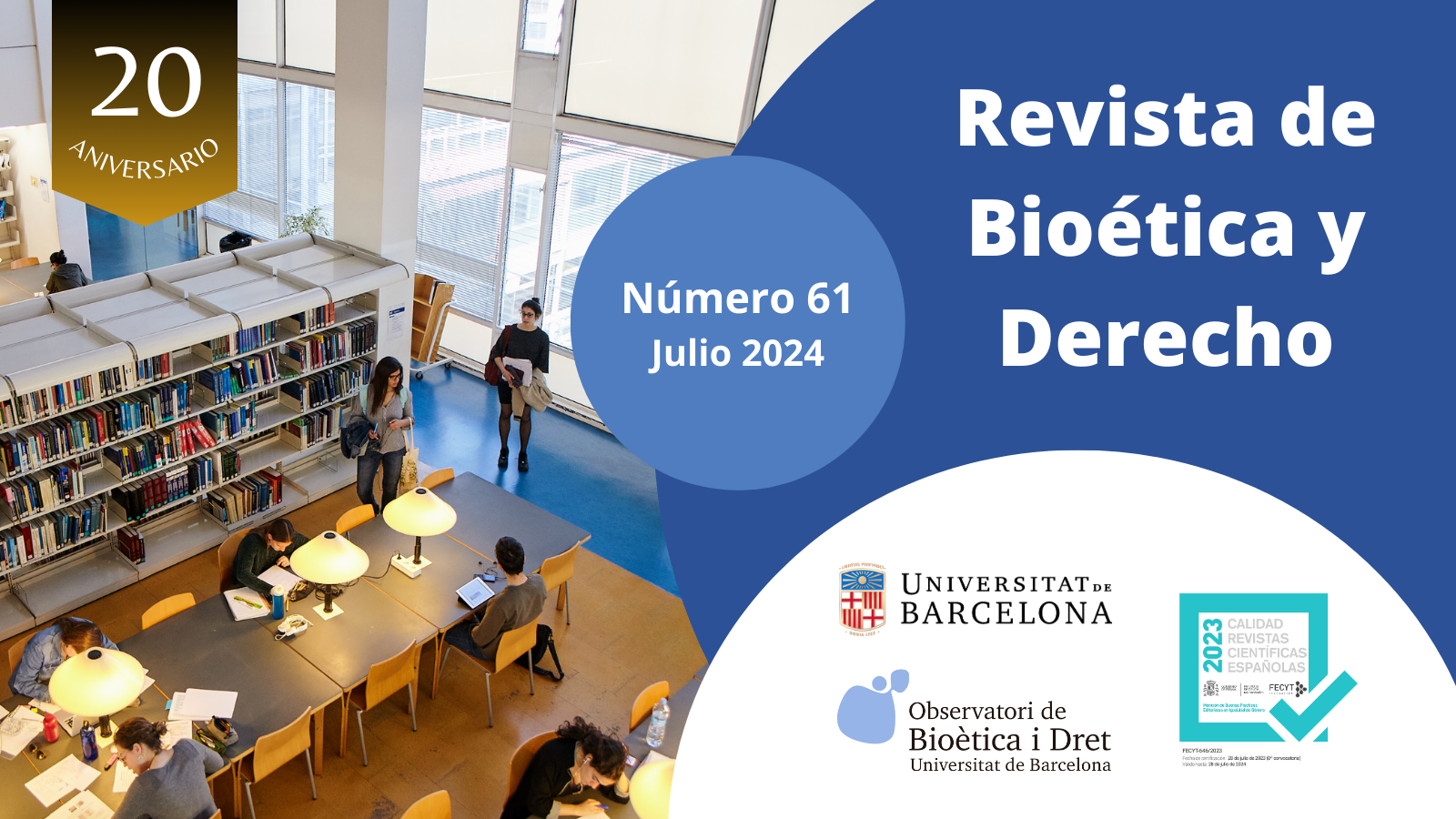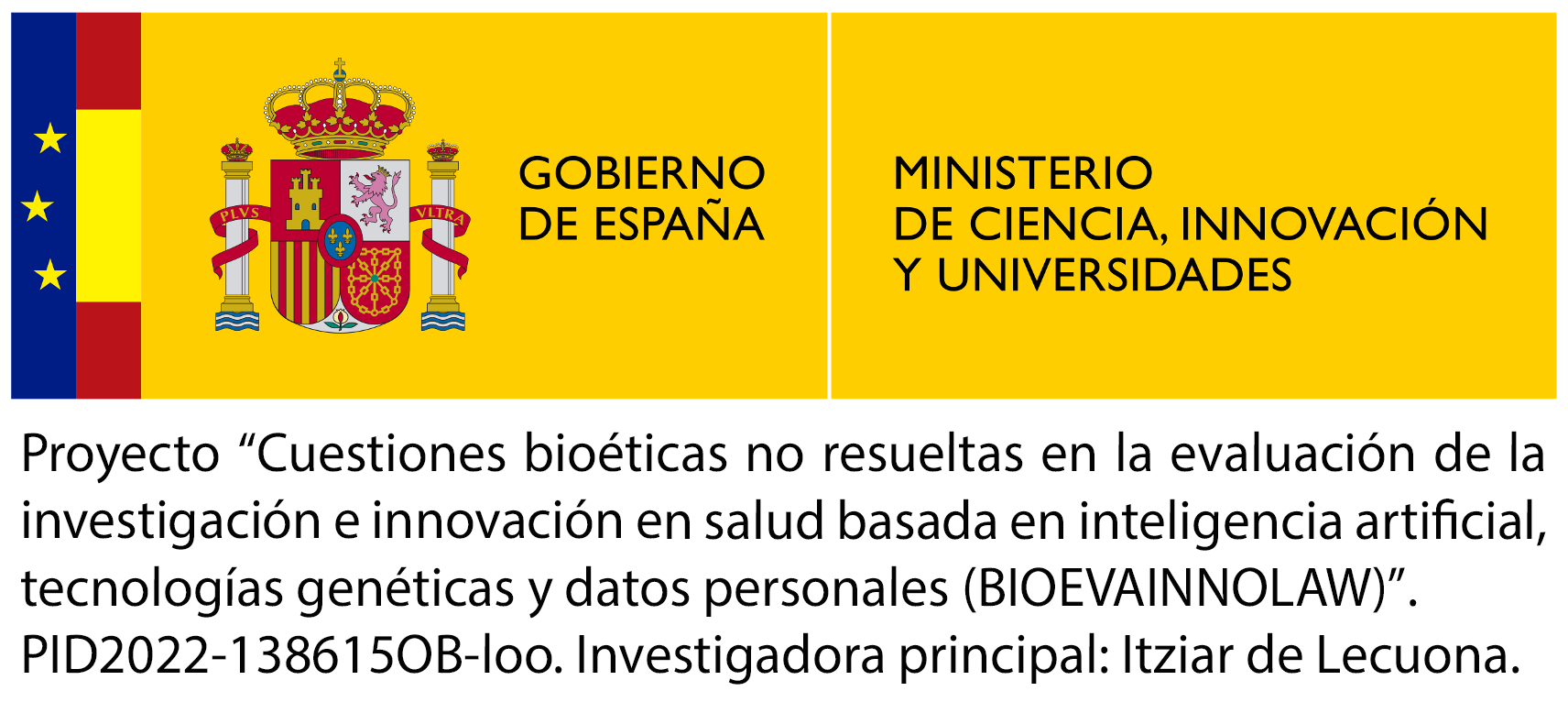Gestació per substitució i mobilitat de biomaterials i éssers humans
Paraules clau:
gestació per substitució, mobilitat de biomaterials humans, mobilitat humana, turisme reproductiu, doble paràmetreResum
La mobilitat de biomaterials humans a Espanya està prohibida per ser utilitzats per a la gestació per substitució. La gestació per substitució igualment no està admesa en l'ordenament jurídic espanyol. Malgrat ambdues prohibicions, nombroses persones viatgen a l'estranger a països on la gestació per substitució és legal per tenir un nadó mitjançant aquesta tècnica. Igualment, és impossible verificar si no es produeixen trasllats de biomaterials humans a altres països per ser utilitzats en processos de gestació per substitució. Aquest cas il·lustra perfectament el doble paràmetre ètic i legal que l'ordenament jurídic espanyol té davant de la medicina reproductiva en general i davant de la mobilitat de biomaterials humans.
Referències
Calhaz, J., et al. (2016). Assisted reproductive technology in Europe, 2012: Results generated from European registers by ESHER. Human Reproduction, 31 (8), 1638–1652.
Cohen, G. (2014). Las fronteras del derecho sanitario: globalización y turismo médico. AFDUAM, 18, 21-44.
Ferraretti, A.P.; Pennings, G.; Gianaroli, L.; Natali, F.; Magli, C. (2010). Cross-border reproductive care: a phenomenon expressing the controversial aspects of reproductive technologies. Reproductive Biomedicine Online, 20, 261-266.
Hudson, N.; Culley, L.; Herbrand, C.; Pavone, V.; Pennings, G.; Provoost, V.; Coveney, C.; Lafuente Funes, S. (2020). Reframing egg donation in Europe: new regulatory challenges for a shifty landscape. Health Policy & technology, 9 (3), 308-313.
Igareda González, N. (2020). Legal and ethical issues in cross-border gestational surrogacy. Fertility & Sterility, 113 (5), 916-919.
Igareda González, N. (2019). Regulating surrogacy in Europe: Common problems, diverse national laws. European Journal of Women’s Studies, 26 (4), 435-446.
Igareda, N. (2018). La gestación por sustitución: una oportunidad para repensar la filiación y la reproducción humana. Revista Bioética y Derecho, 44, 57-72.
Kroløkke, C.H. (2014). West is best: Affective assemblages and Spanish oocytes. European Journal of Women’s Studies, 21 (1), 57–71.
Machin, R.; Augusto, M.H.; Mendosa, D. (2018). Cross-border reproduction: the reproductive market in Angola and Brazil. Papeles del CEIC. International Journal on Collective Identity Research, 2 (198), CEIC (Centro de Estudios sobre la Identidad Colectiva), UPV/EHU Press, http://dx.doi.org/10.1387/pceic.18888.
Marre, D., B. San Román, and D. Guerra (2018). On reproductive work in Spain: transnational adoption, egg donation, surrogacy, medical anthropology. Routledge, 37 (2), 158–173.
Morero, A. (2018). Características de las familias creadas por gestación subrogada en el Estado español. Papeles del CEIC. International Journal on Collective Identity Research, 2 (199), CEIC (Centro de Estudios sobre la Identidad Colectiva), UPV/EHU Press, 2018, http://dx.doi.org/10.1387/pceic.18966.
Lafuente, S. (2019). Shall we stop talking about egg donation? Transference of reproductive capacity in the Spanish Bioeconomy, BioSocieties, 15, 207–225.
Lamm, E. (2012). Gestación por sustitución. Realidad y Derecho. InDret. Revista para el análisis del derecho, 3, 1-49.
Pennings, G. (2006). International parenthood via procreative tourism” in Shenfield, F. and Sureau, C. (eds.). Contemporary ethical dilemmas in assisted reproduction, Abingdon, Oxon: Informa Health Care, 43-56.
Pennings, G. (2007). Ethics without boundaries: medical tourism in Ashcroft, R.; Dawson, A., Draper, H. and McMILLAN, J. (eds.). Principles of health care ethics. London: John Wiley & Sons, 505-510.
Pennings, G.; De Wert, G.; Wert, E.; Shenfield, F.; Cohen, E.; Tarlatzis,B.; and Devroey, P. (2008). ESHRE Task Force on Ethics and Law 15: Cross-border reproductive care. Human Reproduction, 23 (10), 2182-2184.
Pino Avila, A. (2023). La autonomía reproductiva en la jurisprudencia del Tribunal Europeo de Justicia. Pamplona: Aranzadi.
Quiñones, A. (2009). Doble filiación paterna de gemelos nacidos en el extranjero mediante maternidad subrogada. InDret. Revista para el Análisis del Derecho, Barcelona, Julio 2008, 1-25.
Roque, M., Lattes, K., Serra, S., Solà, I., Geber, S., Carreras, R., & Checa., M. A. (2013). Fresh embryo transfer versus frozen embryo transfer in in vitro fertilization cycles: a systematic review and meta-analysis. Fertil Steril, 99(1), 156-162.
Stoll, J. (2013). Surrogacy Arrangements and Legal Parenthood. Swedish Law in a Comparative Context, Uppsala: Uppsala University Publications.
Descàrregues
Publicades
Com citar
Número
Secció
Llicència
Drets d'autor (c) 2024 Noelia Igareda

Aquesta obra està sota una llicència internacional Creative Commons Reconeixement-NoComercial-SenseObraDerivada 4.0.
 Els/les autors/es conserven els drets d'autoria dels articles i autoritzen la Universitat de Barcelona a publicar-los en la seva Revista de Bioética y Derecho i a incloure'ls en els serveis d'indexació i abstracts, bases de dades acadèmiques i repositoris en els quals participa la revista. Els treballs publicats en la Revista de Bioètica i Dret estan sota la llicència Creative Commons Reconeixement-NoComercial-SenseObraDerivada 4.0 Internacional (by-nc-nd 4.0), que permet compartir l'obra amb tercers, sempre que aquests reconeguin la seva autoria, la seva publicació inicial en aquesta revista i les condicions de la llicència. No es permet un ús comercial de l'obra original ni la generació d'obres derivades.
Els/les autors/es conserven els drets d'autoria dels articles i autoritzen la Universitat de Barcelona a publicar-los en la seva Revista de Bioética y Derecho i a incloure'ls en els serveis d'indexació i abstracts, bases de dades acadèmiques i repositoris en els quals participa la revista. Els treballs publicats en la Revista de Bioètica i Dret estan sota la llicència Creative Commons Reconeixement-NoComercial-SenseObraDerivada 4.0 Internacional (by-nc-nd 4.0), que permet compartir l'obra amb tercers, sempre que aquests reconeguin la seva autoria, la seva publicació inicial en aquesta revista i les condicions de la llicència. No es permet un ús comercial de l'obra original ni la generació d'obres derivades.








